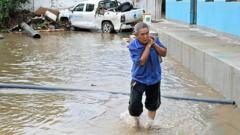The disputed Sandy Cay has become the center of a serious standoff between China and the Philippines, following the flag-raising actions of both nations. With U.S.-Philippines military exercises underway, regional tensions escalate as both countries assert their claims.
Tensions Rise Over Sandy Cay Amid U.S.-Philippines Military Exercises

Tensions Rise Over Sandy Cay Amid U.S.-Philippines Military Exercises
A small sandbar in the South China Sea ignites conflict between China and the Philippines, coinciding with joint military drills between the U.S. and the Philippines.
In the volatile waters of the South China Sea, a tiny sandbar known as Sandy Cay has emerged as the latest battleground for territorial disputes between China and the Philippines. This tiny piece of land, measuring around 200 square meters, has seen the flags of both nations prominently displayed, further intensifying the standoff between the two.
Earlier this month, the Chinese Coast Guard made headlines as they reportedly landed on Sandy Cay and hoisted the Chinese flag, proclaiming their "sovereign jurisdiction." By Sunday, following this demonstration of power, the Philippines responded by deploying its own personnel to the same sandbar, leading to a furious accusation from Beijing of “illegal boarding.” The Chinese government asserts that it holds “indisputable sovereignty” over the Spratly Islands, which encompass Sandy Cay and many other landforms in these strategically significant waters.
These tensions come at a time when the Philippines is engaged in its annual military exercises with the United States, a long-time ally that has vowed to support Manila in the event of aggression. China has criticized these exercises, viewing them as a provocateur undermining regional peace.
The conflict over Sandy Cay may indicate broader ambitions by China to reinforce its claims around Subi Reef, where it has established military infrastructure on reclaimed territory. The ongoing assertiveness of Beijing in the South China Sea, particularly in the Spratly Islands, has been a growing concern for regional stability, as it often involves landforms and waters critical to both national and international interests.
As the geopolitical landscape continues to evolve, the situation surrounding Sandy Cay exemplifies the complexities of territorial disputes in the region, making it clear that both nations are prepared to defend their claims. The implications of this stand-off will likely resonate well beyond the immediate area, affecting international relations and stability across the broader Asia-Pacific region.
Earlier this month, the Chinese Coast Guard made headlines as they reportedly landed on Sandy Cay and hoisted the Chinese flag, proclaiming their "sovereign jurisdiction." By Sunday, following this demonstration of power, the Philippines responded by deploying its own personnel to the same sandbar, leading to a furious accusation from Beijing of “illegal boarding.” The Chinese government asserts that it holds “indisputable sovereignty” over the Spratly Islands, which encompass Sandy Cay and many other landforms in these strategically significant waters.
These tensions come at a time when the Philippines is engaged in its annual military exercises with the United States, a long-time ally that has vowed to support Manila in the event of aggression. China has criticized these exercises, viewing them as a provocateur undermining regional peace.
The conflict over Sandy Cay may indicate broader ambitions by China to reinforce its claims around Subi Reef, where it has established military infrastructure on reclaimed territory. The ongoing assertiveness of Beijing in the South China Sea, particularly in the Spratly Islands, has been a growing concern for regional stability, as it often involves landforms and waters critical to both national and international interests.
As the geopolitical landscape continues to evolve, the situation surrounding Sandy Cay exemplifies the complexities of territorial disputes in the region, making it clear that both nations are prepared to defend their claims. The implications of this stand-off will likely resonate well beyond the immediate area, affecting international relations and stability across the broader Asia-Pacific region.
















